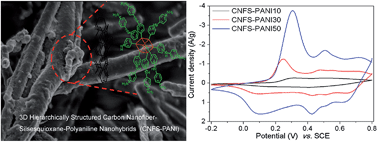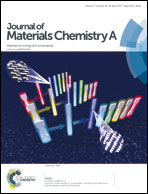Hierarchically structured carbon nanofiber–silsesquioxane–polyaniline nanohybrids for flexible supercapacitor electrodes†
Abstract
In this report, in contrast to conventional processes which rely upon non-covalent wrapping, we manipulate the covalent binding of conjugated polymers to carbon nanofibers to synthesize hybrid nanostructures. First, the Friedel–Crafts acylation reaction was utilized to introduce carboxyl groups onto the nanofiber sidewalls. Octa-aminophenylsilsesquioxane was then uniformly covalently attached to the carboxylated nanocarbon (CNF–COOH) through amide linkage. Subsequently, the phenylamino groups on the CNF surface were copolymerized with aniline via chemical oxidative polymerization to create a unique CNF-conjugated polymer hybrid (CNFS–PANI), and a binder-free CNF-based composite paper electrode was generated by vacuum-filtration. Morphology investigations revealed the formation of 3D porous interconnected network structures with loosely stacked hyperbranched PANI nanobundles due to the incorporation of OASQ onto the skeleton of CNFs. Such a flexible CNFS–PANI nanohybrid paper further exhibited excellent electric conductivity (0.31 S cm−1) and specific capacitance (167 F g−1), which is much higher than that of original CNFs (2.5 F g−1), suggesting its potential use as an electrochemical electrode material.


 Please wait while we load your content...
Please wait while we load your content...